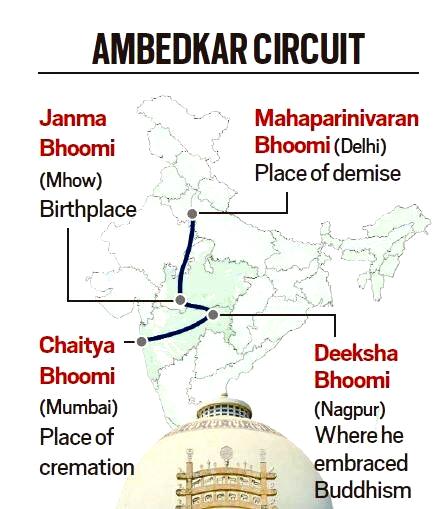Indian History
Ambedkar Circuit
- 26 Sep 2022
- 7 min read
For Prelims: Ambedkar Circuit, Panchteerth, Mahad Satyagraha, Poona Pact, Swadesh Darshan scheme
For Mains: Contribution of Dr B.R Ambedkar
Why in News?
Recently, the Central government announced a special tourist circuit named Ambedkar circuit, which encompasses five key sites associated with Dr B.R. Ambedkar.
What is Ambedkar Circuit?
- About:
- The government had first proposed the Ambedkar Circuit, or Panchteerth, in 2016, but the conceptualisation of the plan could be held recently.
- The five cities in the tourist circuit as announced by the government are:
- Janma Bhoomi- Ambedkar’s birthplace in Madhya Pradesh’s Mhow.
- Shiksha Bhoomi- the place in London where he stayed while studying in the UK.
- Deeksha Bhoomi- the place in Nagpur where he embraced Buddhism.
- Mahaparinirvan Bhoomi- the place of his demise in Delhi.
- Chaitya Bhoomi- the place of his cremation is in Mumbai.
- Significance:
- Focus on Tourism:
- The idea is to attract tourists beyond the Dalit community, who mostly visit these places as a pilgrimage.
- The journey will include meals, ground transportation, and entry to the site.
- Development of the Area:
- The creation of special circuits allows the government to focus better on the comprehensive development of all sites related to the theme, including infrastructure, road and rail connectivity, and visitor facilities.
- Focus on Tourism:
What are the Issues Related to Ambedkar Circuit?
- Promoting Government’s Local and Nationalistic Perspective:
- Various Dalit scholars and Ambedkarites argued that the five spots do not do justice to Ambedkar’s real legacy and have been chosen to just fit into a “localised and nationalistic” narrative of the government.
- Lack of other Important Sites:
- Critics claim that there are a host of other sites which did not get recognition like:
- In the Raigarh district of Maharashtra where Dr Ambedkar led the Mahad Satyagraha,
- Pune, where he held the first negotiations with Mahatma Gandhi in Yerwada jail on a separate electorate for depressed classes,
- The result was the Poona Pact signed by Dr Ambedkar on behalf of the depressed classes and by Madan Mohan Malviya on behalf of upper caste Hindus.
- Sri Lanka, where he attended a Buddhist conclave that is said to have influenced him to convert to Buddhism,
- Kolhapur, where in March 1920, another legendary social reformer, Chatrapati Shahuji Maharaj, declared Dr Ambedkar the true leader of the oppressed classes in India.
- Critics claim that there are a host of other sites which did not get recognition like:
What are Other Tourism Circuits?
- The government had identified 15 tourist circuits under the Swadesh Darshan scheme in 2014-15.
- Besides the Ramayana and Buddhist Circuits, others include Coastal Circuit, Desert Circuit, Eco Circuit, Heritage, North East, Himalayan, Sufi, Krishna, Rural, Tribal, and Tirthankar Circuits.
- In terms of train collaboration, the Ramayana, Buddhist, and North East Circuits are already active, while Ambedkar will be fourth.
What do we Know about Dr B.R Ambedkar?
- About:
- Dr. B.R. Ambedkar was born in 1891 in Mhow, Central Province (now Madhya Pradesh).
- He is known as the Father of the Indian Constitution and was India's first Law Minister.
- He was the Chairman of the Drafting Committee for the new Constitution.
- Dr. Ambedkar was a social reformer, jurist, economist, author, polyglot (knowing or using several languages) orator, a scholar and thinker of comparative religions.
- He participated in all three Round Table Conferences.
- In 1932 Dr. Ambedkar signed the Poona pact with Mahatma Gandhi, which abandoned the idea of separate electorates for the depressed classes (Communal Award).
- However, the seats reserved for the depressed classes were increased from 71 to 147 in provincial legislatures and to 18% of the total in the Central Legislature.
- His ideas before the Hilton Young Commission served as the foundation of the Reserve Bank of India (RBI).
- In 1936, he was elected to the Bombay Legislative Assembly as a legislator (MLA).
- He was appointed to the Executive Council of Viceroy as a Labour member in 1942.
- In 1947, Dr. Ambedkar accepted PM Nehru's invitation to become Minister of Law in the first Cabinet of independent India.
- He resigned from the cabinet in 1951, over differences on the Hindu Code Bill.
- He converted to Buddhism. He passed away on 6th December 1956. Chaitya Bhoomi is a memorial to B. R. Ambedkar, located in Mumbai.
- Contributions:
- Journals: Dr. Ambedkar launched various journals like:
- Mooknayak (1920),
- Bahishkrit Bharat (1927),
- Samatha (1929),
- Janata (1930).
- Books:
- Annihilation of Caste,
- Buddha or Karl Marx,
- The Untouchable: Who are They and Why They Have Become, Untouchables,
- Buddha and His Dhamma,
- The Rise and Fall of Hindu Women.
- Organisations:
- Bahishkrit Hitkarini Sabha (1923),
- Independent Labor Party (1936),
- Scheduled Castes Federation (1942).
- Journals: Dr. Ambedkar launched various journals like:
UPSC Civil Services Examination Previous Year Question (PYQ)
Prelims
Q . Which of the following parties were established by Dr. B. R. Ambedkar? (2012)
- The Peasants and Workers Party of India
- All India Scheduled Castes Federation
- The Independent Labour Party
Select the correct answer using the codes given below:
(a) 1 and 2 only
(b) 2 and 3 only
(c) 1 and 3 only
(d) 1, 2 and 3
Ans: (b)
Exp:
- The Peasants and Workers Party of India was formed by Keshavrao Jedhe of Pune, Shankarrao More and others in 1947. Hence, 1 is not correct.
- All India Scheduled Castes Association was established by B. R. Ambedkar in 1942 and this party participated in general elections in 1946. Hence, 2 is correct.
- The Independent Labour Party (ILP) was also formed by B. R. Ambedkar in 1936, which participated in the provincial elections of Bombay. Hence, 3 is correct. Therefore, option (b) is the correct answer.





